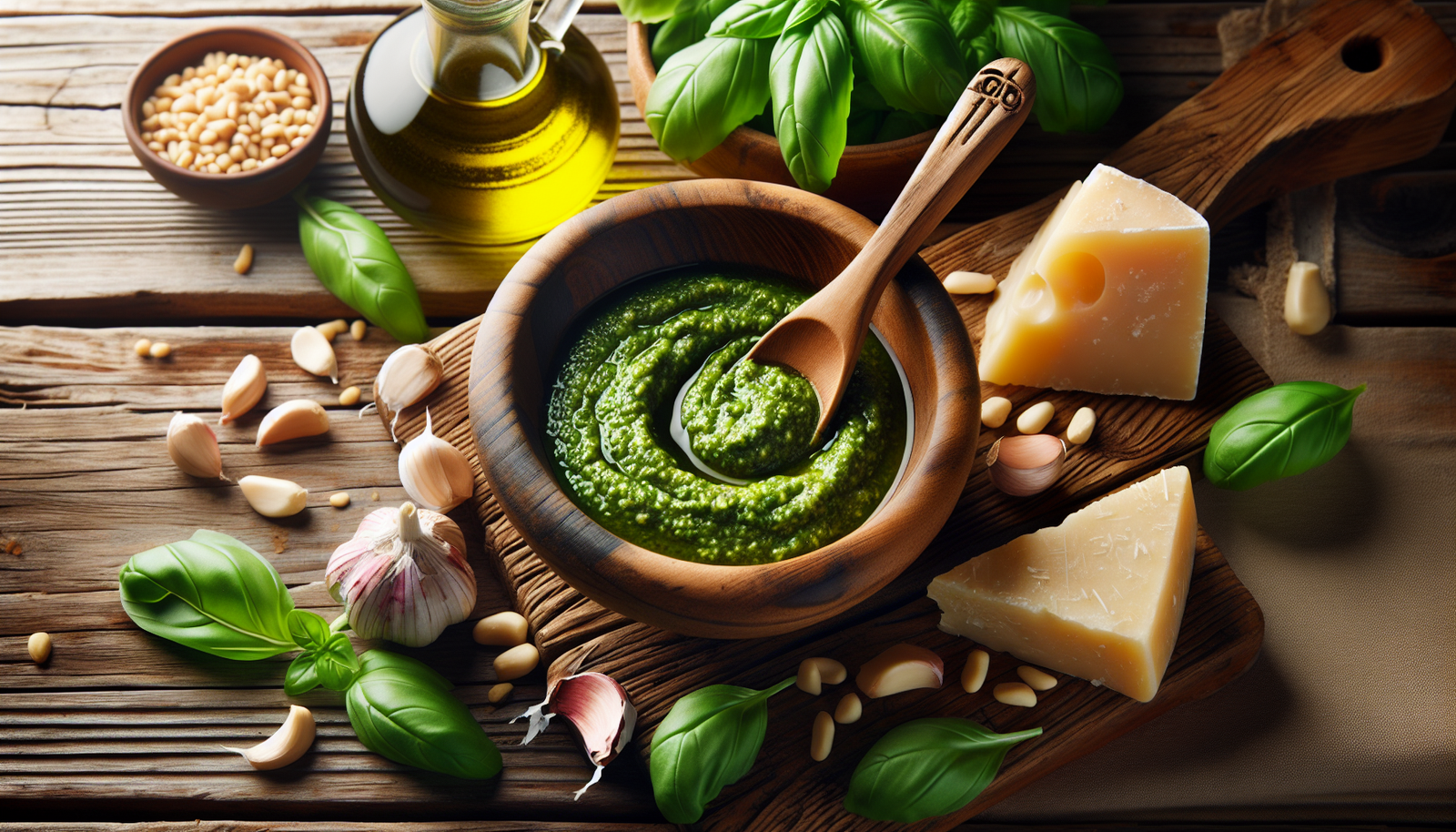
How to Make a Simple Pesto Sauce: Fresh and Delicious
Make pesto sauce a staple in your kitchen with this simple and delicious recipe. Did you know that pesto originated in Genoa, Italy, hundreds of years ago? This classic sauce, bursting with fresh basil, garlic, olive oil, pine nuts, and Parmesan cheese, brings a vibrant touch to any dish. This post will guide you through the easy steps to craft your homemade pesto, offering tips to perfect the consistency and taste. Once you experience the aromatic and savory flavors of pesto, you’ll understand why it has remained a beloved sauce worldwide.
Understanding Pesto Sauce and Its Origins
Pesto sauce, a vibrant green condiment bursting with flavor, has delighted palates for centuries. Its roots are deeply intertwined with Italian gastronomy, embodying a rich culinary tradition. This section explores the history, essential ingredients, and regional variations that make pesto a beloved staple worldwide.
The History and Tradition of Italian Pesto
Pesto’s story begins in the Liguria region of Italy, renowned for its aromatic basil. Historically, pesto was crafted using a mortar and pestle, giving the sauce its name, derived from the Italian word “pestare,” meaning to pound or crush. This method ensured that the basil leaves released their flavorful oils, creating a sauce that was not only delicious but also aromatic.
In Ligurian culture, pesto is more than a condiment; it’s a symbol of regional pride. Families pass down their unique recipes through generations, each adding their own twist to the traditional blend. The first written recipe dates back to the 19th century, though the sauce’s roots are believed to reach back much further. Pesto’s simplicity and versatility have helped it endure, making it a timeless addition to many Italian dishes.
Key Ingredients of Traditional Pesto Sauce
Traditional pesto sauce is a harmonious blend of simple yet flavorful ingredients. The star is Genovese basil, known for its sweet and peppery notes. Freshly grated Parmigiano-Reggiano and Pecorino cheeses add a salty richness, while pine nuts provide a creamy texture and nutty flavor. Extra virgin olive oil binds the ingredients together, imparting a fruity and robust quality.
Garlic, another essential component, gives the sauce its distinctive pungency. The balance between these ingredients creates the classic pesto flavor profile: vibrant, earthy, and rich. While modern conveniences like blenders and food processors have replaced the mortar and pestle, capturing the essence of traditional pesto remains paramount.
Different Variations of Pesto Across Regions
Though pesto originated in Liguria, its popularity has inspired countless variations across Italy and beyond. In Sicily, you’ll find pesto alla Trapanese, which replaces pine nuts with almonds and incorporates tomatoes. This version is both sweet and tangy, offering a refreshing take on the classic recipe.
Elsewhere in Italy, walnuts often substitute pine nuts, creating a heartier flavor. In Provence, France, pistou is a basil-based sauce similar to pesto but omits nuts and cheese, resulting in a lighter and herb-forward flavor profile.
Globally, pesto variations include ingredients like arugula, kale, or sun-dried tomatoes, each bringing unique flavors to the table. These adaptations demonstrate pesto’s versatility and its ability to complement a variety of cuisines and personal tastes.
How to Make Pesto Sauce at Home
Crafting pesto at home allows control over flavor and freshness. This section guides you through selecting the finest ingredients, preparation techniques, and tips to achieve that perfect texture and taste. With a bit of practice, homemade pesto can rival any store-bought option.
Selecting the Best Fresh Ingredients for Pesto
The foundation of great pesto lies in fresh, high-quality ingredients. For basil, opt for vibrant, green leaves free of blemishes. The fresher the basil, the more aromatic and flavorful the pesto will be. When it comes to cheese, a freshly grated Parmigiano-Reggiano or Pecorino ensures a rich, savory depth.
For nuts, choose pine nuts that have a creamy texture and subtle flavor. Toasting them lightly can enhance their natural nuttiness. Extra virgin olive oil should be fruity and robust to complement the other ingredients. Lastly, fresh garlic cloves are essential for their pungent kick, but be careful not to overpower the other flavors.
Step-by-Step Pesto Preparation Guide
Creating pesto at home is a straightforward process. Begin by gently washing the basil leaves and patting them dry. In either a traditional mortar and pestle or a modern food processor, combine the garlic and pine nuts, grinding them into a coarse paste.
Add the basil leaves gradually, ensuring they are thoroughly incorporated. Drizzle in the olive oil slowly, allowing the ingredients to emulsify into a smooth sauce. Finally, add the grated cheeses, blending until the pesto reaches your desired consistency.
Throughout this process, avoid over-blending, which can lead to a bitter taste and loss of vibrant color. The goal is a sauce that is both creamy and slightly textured, capturing the essence of each ingredient.
Tips for Perfecting the Texture and Flavor
Achieving the ideal pesto texture and flavor requires a few key considerations. Balance is crucial; too much garlic can overwhelm, while insufficient cheese can result in a flat taste. Adjusting these elements to suit personal preferences is part of the fun of making pesto.
To maintain the sauce’s vibrant green hue, blanching the basil leaves briefly in boiling water can help, though it’s optional. Using a high-quality olive oil enhances both texture and taste, providing a smooth, cohesive sauce. Tasting and adjusting salt levels ensures the flavors harmonize perfectly.
For a thicker pesto, reduce the amount of olive oil, or increase it for a thinner sauce. Ultimately, the best pesto is one that reflects your palate, embracing both tradition and personal flair.
Serving and Storing Your Homemade Pesto
Pesto is incredibly versatile, enhancing a wide range of dishes beyond pasta. This section explores creative serving ideas, proper storage techniques, and solutions for common pesto-making challenges. Embark on a culinary journey, expanding pesto’s use in your kitchen.
Creative Ways to Serve Pesto Beyond Pasta
While pesto is a classic partner for pasta, its uses extend far beyond. Spread it on sandwiches or burgers for a burst of herbal flavor. Use it as a marinade for chicken or fish, allowing the flavors to infuse the meat before grilling or baking.
Drizzle pesto over roasted vegetables or soups to add a fresh, aromatic finish. It also pairs well with mozzarella or goat cheese, making it a delightful addition to a cheese platter. For a simple appetizer, combine pesto with cream cheese for a savory dip, perfect for crudités or crackers.
Experimenting with pesto in different dishes not only showcases its versatility but also enhances your culinary creativity.
Proper Techniques for Storing Pesto Sauce
Proper storage is vital to maintaining pesto’s vibrant color and flavor. Transfer the sauce into an airtight container, leaving a thin layer of olive oil on top to prevent oxidation. This step preserves the basil’s green hue and the sauce’s fresh taste.
Refrigerate homemade pesto for up to a week, or freeze it for longer storage. Freezing pesto in ice cube trays allows for convenient portioning; simply pop out a cube whenever you need a quick flavor boost. Thaw frozen pesto in the refrigerator overnight for best results.
Avoid reheating pesto, as heat can cause the sauce to lose its fresh, vibrant flavor. Instead, allow it to come to room temperature naturally before serving.
Troubleshooting Common Pesto-Making Problems
Even seasoned cooks encounter challenges when making pesto. If your sauce turns out bitter, it may be due to over-blending or using bitter-tasting olive oil. To remedy this, add a bit more cheese or a squeeze of lemon juice to balance the flavors.
A too-thick pesto can be adjusted by gradually incorporating more olive oil or a splash of pasta water until the desired consistency is reached. For a pesto that lacks flavor, ensure all ingredients are fresh and appropriately seasoned.
Embrace experimentation to discover what works best for you, and soon, making perfect pesto will become second nature.
Conclusion
Pesto sauce is a classic Italian condiment made primarily from fresh basil leaves. Key ingredients include olive oil, pine nuts, garlic, and Parmesan cheese. The ingredients are combined, usually using a food processor, for a smooth consistency. It can be used as a topping for pasta, spread on sandwiches, or as a dip. Adjustments like adding lemon juice or different nuts can personalize the flavor.
FAQ
What ingredients are essential for making authentic pesto sauce?
To craft an authentic pesto sauce, use fresh basil leaves, extra virgin olive oil, garlic cloves, Parmesan cheese, Pecorino cheese, and pine nuts. These ingredients blend together to deliver the classic Italian flavors and rich, aromatic taste that makes pesto a favorite.
How do I store homemade pesto sauce for long-term freshness?
Store homemade pesto in an airtight container, then refrigerate it. To extend its freshness, pour a thin layer of olive oil over the top to prevent air exposure. This method keeps the pesto vibrant and tasty for up to a week.
Can I freeze pesto sauce without affecting its flavor or texture?
Freezing pesto is possible and maintains its flavor and texture. Use ice cube trays for portioned servings, then transfer the frozen cubes to a freezer-safe bag. This technique helps easily access the perfect amount for future meals.
What are the best alternatives to pine nuts in a pesto recipe?
Substitute pine nuts with options like walnuts, almonds, or cashews. Each offers a unique twist on the classic recipe, maintaining the pesto’s nutty essence while accommodating different taste preferences and budget considerations.
How do I keep pesto sauce from turning brown once made?
To prevent browning, reduce the pesto’s exposure to air by storing it with a layer of olive oil on top. Using lemon juice during preparation also helps preserve its vibrant green color.
Is it possible to make a vegan version of traditional pesto sauce?
Creating a vegan pesto is simple. Replace Parmesan with nutritional yeast for a cheesy flavor. Ensure all other ingredients are plant-based, maintaining the authentic taste while accommodating vegan dietary preferences.











